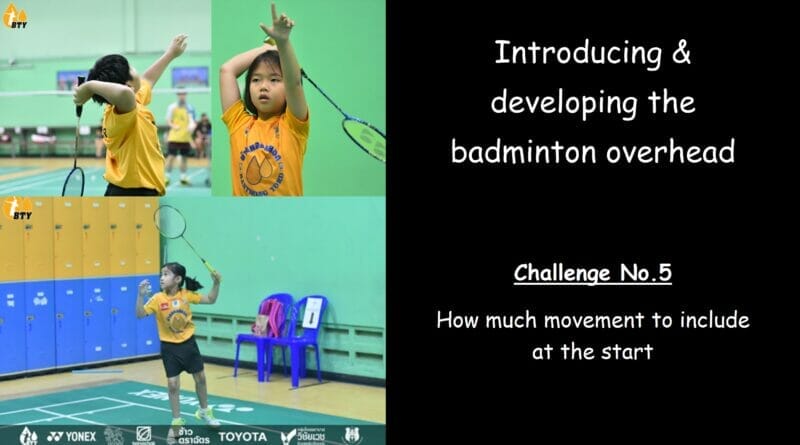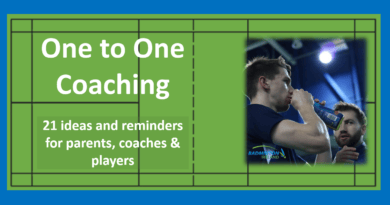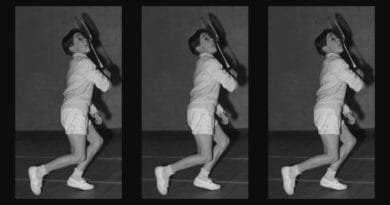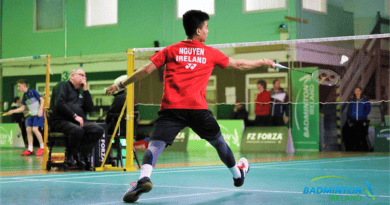Introducing the badminton overhead – Challenge No. 5
What do your early practices with beginners look like?
How much movement do you include in your practices?
When & how to include movements can be a tough decision – do you agree?
Performing movement patterns without any previous experience can be problematic
but also stripping away too much movement needs consideration
Understanding why you choose what you do is important
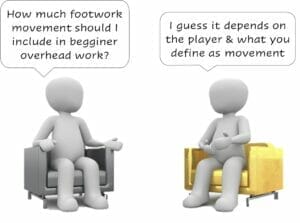 This post is part of a mini-series that examines the various challenges that coaches face when first introducing overhead forehand striking to beginner players. Your challenge is to decide how much movement you think is effective as a first experience.
This post is part of a mini-series that examines the various challenges that coaches face when first introducing overhead forehand striking to beginner players. Your challenge is to decide how much movement you think is effective as a first experience.
This question or challenge, depending on how you feel is specifically aimed at when you are working with young beginner players.
You may feel challenged or ‘prickled’ at some of the points raised. My aim is to give you ideas to help make the learning a little easier and to create more smiles than struggles in your coaching sessions 🙂
I think it’s important to use your experience based on observations and results to decide which movements create the most effective developments. I’m sure there are pros and cons to all we choose, all I ask is that you consider your core themes.
It’s often important to know why you chose not to do something. There will be times when you could make a choice but chose not to as it doesn’t benefit the player or players in front of you right now.
I’m not here to change your mind, just to ask you to consider your ‘why’
Why you chose to do what you do
– – – – – – – – – – – – – – – –
Some background information

If you haven’t read the introductory post I recommend you click here or this image.
It outlines 5 challenges coaches face and why I believe that this movement also attracts the most coaching problems. Maybe even more than an overhead backhand.
You will find a link to each of the 5 separate posts that work through the coach challenge point.
There is also an insight into what happened when I spoke with 2 other coaches about these challenges and how at times, we disagreed! I’ve outlined some of the thoughts we had during our conversation.
– – – – – – – – – – – – – – – – – –
Starting with complete movements, is that best?
Why is it important to discuss this?
The argument for including whole movements
The argument against
It’s your choice
I hope to prickle your thoughts
– – – – – – – – – – – – – – – –
Why is it important to discuss this?
How many coaches do you know that consider the different ways of introducing the overhead forehand.
If you work with young players are you talking to other coaches about the effectiveness of what you do. I recommend that you work with a few critical friends that are willing to consider different ideas, try different experiments, or even have challenging discussions.
If your goal is to get players striking overhead very early in their development in a practice that contains movements, are you happy with what you experience and observe?
Or, do you prefer to remove movements such as pushing up off the ground (mini-jump), or maybe you like to isolate the throw with almost no movement at all.
These are the 2 extremes of what you could do, or do you just have your preferred go-to method?
– – – – – – – – –
Do your practices create the foundation for the future development you want?
or
Do you see ‘errors’ that you are willing to accept, knowing you can change them later?
– – – – – – – – –
These questions will provide you with information to consider not only what you do in your coaching, but why you choose to do it. Often we repeat practices we’ve seen or that we have always done without really questioning why we do them.
Striking and moving for overheads is complex and sometimes full of messy outcomes for young beginner players. Deciding how complex the task is (especially the movement element) is a skill that coaches need to develop. Please consider if it’s worth experimenting or talking about what you do. Your aim should be to have a range of options that ultimately provides the best experiences that can be built on.
How soon would you introduce a whole body rotation plus striking?
I’m a little undecided over the question of how much movement is best to include, especially if it includes striking a shuttle delivered by another player or a coach. Over the years I’ve seen a few different methods and a combination of these methods and I’ve tried lots of different methods.
Currently, I don’t favour introducing the overhead with complex movement patterns combined with striking
but
I also don’t recommend that movement (such as mini-jumping) is stripped out of the practice
However, I can understand why coaches, players and even parents would expect to start with a complex overhead hitting practice. It’s what happens in a rally and they believe that in order to ‘play’ badminton you need to start hitting overheads.
My issue is that most coaches know what will happen in this practice and either accept it (see challenge no.2) or just deal with the consequences afterwards. I’ve often heard coaches say “I can correct any technique ‘errors’ afterwards, it’s just important that they get a feel for the whole movement early on”
I’m not sure this is the best approach for player or coach. What do you think of the arguments I set out in Challenge No. 2
All coach education courses I’ve seen only ever show the coaching of the overhead as a whole striking movement (apart that is from the BWF Shuttletime). I wonder why that is, why would Shuttletime be different?
What do you generally expect to happen in beginner overhead striking practices?
Especially if you include whole movements or very limited movements.
Recognise any of these:
- Players not connecting & either miss-hitting or missing the shuttle completely in more than 40% of the attempts
- Players using push actions with limited or no backswing
- Having most of their weight on the front leg with the rear leg off the ground at the time of contact
- Appearing to feel de-motivated and losing enthusiasm for the practice, verbalising that the practice is too difficult or tough
Do you see these results?
If you do what are your feelings about each?
– – – – – – – – – – – – – – – –
The argument for the whole movements
There must be good reasons to start with a complete overhead throwing action that includes striking and movement to the shuttle, as many coaches do exactly this. However, do we know their reasons, their ‘why’?
If coaching is a ‘deliberate’ activity then we must assume the reasons for a coach’s actions have been thought out. The ‘how’ and ‘why’ of what we do is important.
I sat down with a coaching friend and chatted about the reasons for introducing overhead striking as a complete action, including movements. It was an open, enjoyable, but sometimes ‘prickly’ conversation.
We came up with these statements – what thoughts do they trigger?
- It’s important that players see and experience moving & striking as without this they have no reference to what is being asked of them. (Trying and failing is ok)
- If the coach can give a great demonstration then why waste the opportunity? Ask players to copy what the coach (or other players) can do.
- It’s a faster way of teaching as it allows the players to self-organise once they see what is required to move and strike overhead.
- Breaking the movement into smaller parts (chunks) is too time-consuming, and then requires these parts to be put back together.
- There are some young players who have very few issues overhead striking overhead (maybe they have already experienced this from another sport). Why limit these players with part practices.
- It was the way that the coach developed their overhead hitting and not being successful at the start of a process is part of the learning.
How many of these statements do you agree with?
– – – – – – – – – – – – – – – –
The argument against
This isn’t a criticism of coaches who decide to start with the whole movements, which include striking with complex moving. Often if we explore what alternatives there are and what benefits they bring, the coach can be better prepared and have more options.
The question I have is :
If you believe that the likelihood of success is low (in terms of the players’ wants and the coach’s needs) within the first 6 months for the overhead forehand then how much movement to include?
Do you agree with these statements?
- The expectation of success (from most coaches) is that players will not be successful, and often that’s what happens. Why therefore would you add movements to an already complex stroke action?
- Future limiting (inappropriate) techniques can easily develop as a consequence of players trying to simplify their actions to achieve success. The techniques that appear don’t help future development and require large amounts of coach attention to resolve.
- Watching and accepting these ineffective techniques develop can be mentally taxing for the coach. If you agree, how do you hide these thoughts from your players or even yourself?
- Any stutters or miss-timed elements (however small) can result in gross errors and negative outcomes. These lower motivation and can increase emotional stress (of both player, coach and parent).
- Failures can lead to a loss of confidence in the coach and the practice, although the coach may be unaware.
How many of these statements do you agree with?
– – – – – – – – – – – – – – – –
It’s your choice
But first a task!
Consider what experiences could help players in this complex movement. How could you best prepare players, emotionally and technically?
Write a short list with points under each of these 2 headings: emotional and technical. Which will column will you find easier?
Then talk with a coaching friend and discuss your thoughts and opinions. Be open to where this conversation may take you, and explore the ‘prickly subjects 🙂
All I ask is that you consider how much and what movements to introduce and when. That you are happy with the reasons why it’s your preferred method and that it’s best for the player in front of you at that time.
Use well-chosen practices and different methodologies to lay a foundation for overhead striking
– Coach with intent!
Whatever you choose (and it’s up to you and only you to choose), imagine if by doing this you could make the task of specifically developing overheads much easier.
- Reducing the likelihood of classic overhead technical errors, of which there are many.
- Reducing the number of gross errors (complete miss-hits)
- Giving players confidence in their ability to work through challenges that they will face
Plan to develop parts of the overhead forehand through different practices and methodologies
employ these before starting to specifically coach it
– – – – – – – – – – – – – – – –
I hope to prickle your thoughts and beliefs 🙂
My desire is that you will consider the discussion points and challenges, I hope you have time to do that. The ideas and suggestions listed here are my best advice at this time. It’s up to you to decide what to take, use, and maybe reject.
Please do not assume that every statement or bullet point about the overhead forehand listed is essential or has an equal weighting. Some are ‘could haves’ and others are essential ‘must haves’
I’m still not sure that there is one method that works best, but there are certain factors that you need to consider. The other posts in this mini-series will hopefully give you lots to consider.
I wonder how much of the classic (one size fits all) overhead forehand information that is shown on coach education courses applies to this age range. I’d suggest that it’s tougher to coach than the course suggests.
Often the timing of the coach action is more important than what is done by the player
This is the ‘hidden’ coaching skill.

